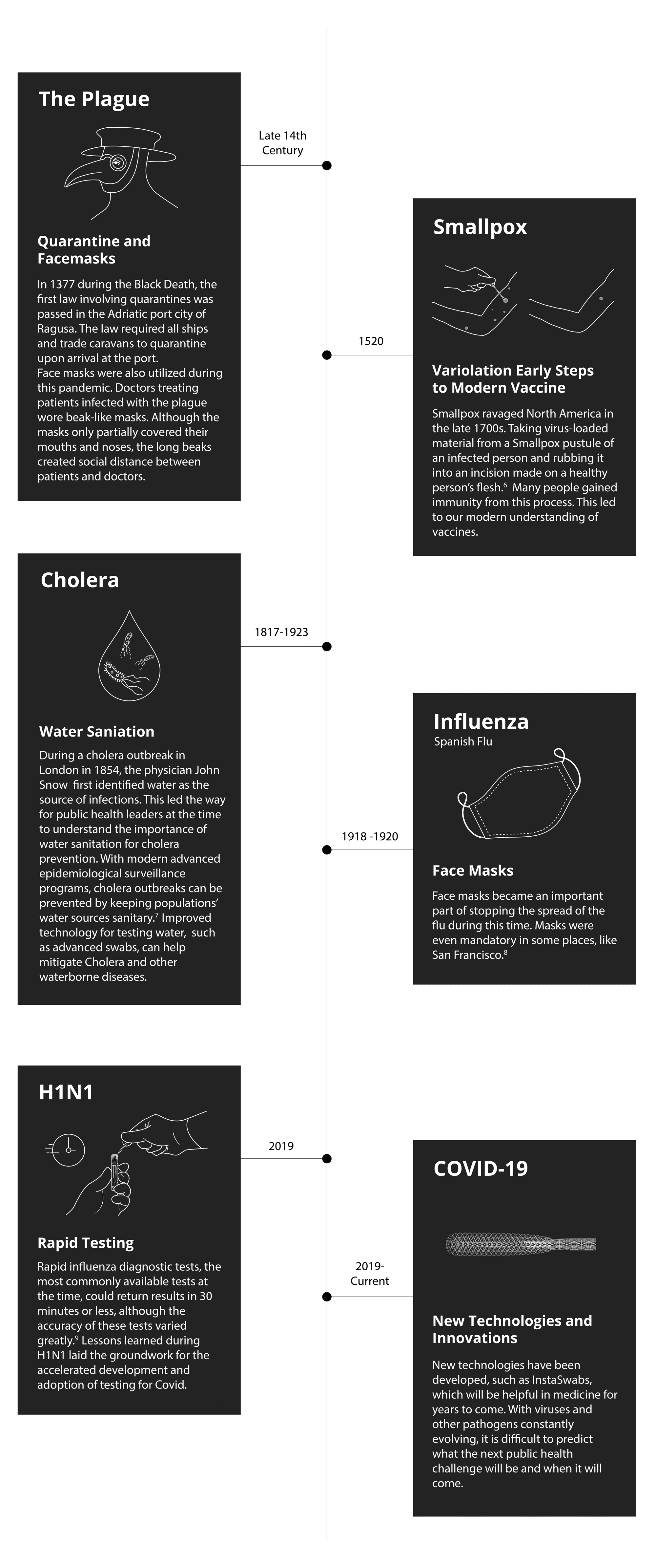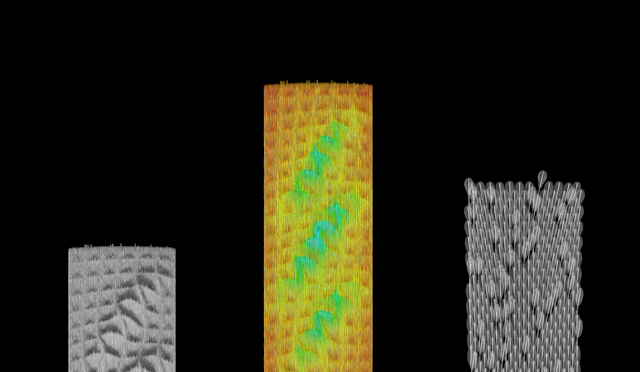How past pandemics drove innovation in public health
How past pandemics drove innovation in public health
What is a pandemic?
Let’s start with a definition of what a pandemic is and how it is different from an endemic or an epidemic. An endemic is a disease that is consistently present in a certain population or area and has a predictable number of infections.1 Meanwhile, an epidemic refers to when there is an unexpected, often sudden increase in the number of cases in a population or area.2 Lastly, a pandemic refers to an epidemic that spreads across several countries or continents.3
Lessons learned from pandemics throughout history
Pandemics can greatly increase morbidity and mortality and can cause significant economic, social, and political disruption. To mitigate the impact of pandemics in the future, we need to learn from the past. Past pandemics taught doctors and ordinary people lessons about public health such as the importance of face masks, quarantining, and contact tracing. Here is an overview of some of the most significant pandemics of the past and what we can take away from them.

The plague, caused by the flea-borne bacteria Yersinia pestis, was responsible for at least three pandemics in history, including the Black Death.4 In 1377 during the Black Death, the first law involving quarantines was passed in the Adriatic port city of Ragusa. The law required all ships and trade caravans to quarantine upon arrival at the port. Face masks were also utilized during this pandemic. Doctors treating patients infected with the plague wore beak-like masks. Although the masks only partially covered their mouths and noses, the long beaks created social distance between patients and doctors. At the time, people believed in the inaccurate theory that the plague spread through bad smells and doctors often put strongly-scented herbs in the beaks of their masks in an attempt to prevent the disease.
Smallpox ravaged North America in the late 1700s. During this period, people used a process called variolation — taking virus-loaded material from a Smallpox pustule of an infected person and rubbing it into an incision made on a healthy person’s flesh.6 Many people gained immunity from this process. This led to our modern understanding of vaccines.
Cholera is an acute disease of the gastrointestinal tract caused by Vibrio cholerae, which is a comma-shaped bacteria transmitted through feces as well as food or water contaminated by the fecal matter of infected people.7 During a cholera outbreak in London in 1854, the physician John Snow first identified water as the source of infections. This led the way for public health leaders at the time to understand the importance of water sanitation for cholera prevention. With modern advanced epidemiological surveillance programs, cholera outbreaks can be prevented by keeping populations’ water sources sanitary.7 Improved technology for testing water, such as advanced swabs, can help mitigate Cholera and other waterborne diseases.
Influenza viruses are single-stranded RNA viruses, which can be highly contagious from person to person. One infamous example of an influenza pandemic is the 1918 Spanish flu. Face masks became an important part of stopping the spread of the flu during this time. Masks were even mandatory in some places, like San Francisco.8 People who did not comply were subject to fines, imprisonment, and the threat of having their names printed in newspapers as “mask slackers”.8 Quarantines were also enforced in many American cities as soldiers returned from World War I.8 In addition, contact tracing was recognized as an important public health measure to control transmission.
The H1N1 pandemic in 2009 was a time when testing played an important role in mitigating infections. Rapid influenza diagnostic tests, the most commonly available tests at the time, could return results in 30 minutes or less, although the accuracy of these tests varied greatly.8 There were also PCR tests available, but they could only be done in certain laboratories and took several days to deliver results.9 Lessons learned during H1N1 laid the groundwork for the accelerated development and adoption of testing for Covid.
Lessons Learned from the COVID-19 Pandemic
Though the COVID-19 pandemic is not yet over, public health experts, scientists, doctors, lawmakers, and ordinary people have learned valuable lessons from this difficult time. We have learned about the dangers of misinformation spreading during a public health crisis. New technologies have been developed, such as InstaSwab or Next Generation Sequencing (NGS)10, which will be helpful in medicine for years to come. With viruses and other pathogens constantly evolving, it is difficult to predict what the next public health challenge will be and when it will come. However, learning from the past is one of the most helpful ways to prepare for the future. Though the COVID-19 pandemic has been an immensely challenging time, innovations and lessons that came out of this period will hopefully help mitigate pandemics in the future.
Bibliography
- Columbia Public Health. Epidemic, Endemic, Pandemic: What are the Differences? https://www.publichealth.columbia.edu/public-health-now/news/epidemic-endemic-pandemic-what-are-differences. Published 2021. Accessed July 30, 2021.
- CDC. Principles of Epidemiology | Lesson 1 – Section 11. https://www.cdc.gov/csels/dsepd/ss1978/lesson1/section11.html. Accessed July 30, 2021.
- Kelly H. The classical definition of a pandemic is not elusive. Bull World Health Organ. 2011;89(7):540-541. doi:10.2471/BLT.11.088815
- Piret J, Boivin G. Pandemics Throughout History. Front Microbiol. 2020;11:631736. doi:10.3389/fmicb.2020.631736
- Roos D. The Term “Quarantine” Comes From Medieval Efforts to Fight the Black Death – HISTORY. https://www.history.com/news/quarantine-black-death-medieval. Published 2020. Accessed July 30, 2021.
- Marshall L. 6 lessons we can learn from past pandemics | CU Boulder Today | University of Colorado Boulder. https://www.colorado.edu/today/2020/04/08/6-lessons-we-can-learn-past-pandemics. Published 2020. Accessed July 30, 2021.
- Somboonwit C, Menezes LJ, Holt DA, Sinnott JT, Shapshak P. Current views and challenges on clinical cholera. Bioinformation. 2017;13(12):405-409. doi:10.6026/97320630013405
- Mozes A. Four Lessons From the 1918 Spanish Flu Pandemic. https://www.webmd.com/lung/news/20200420/four-lessons-from-the-1918-spanish-flu-pandemic#1. Accessed July 30, 2021.
- CDC. CDC H1N1 Flu | Influenza Diagnostic Testing During the 2009-2010 Flu Season. https://www.cdc.gov/h1n1flu/diagnostictestingpublicqa.htm. Published 2009. Accessed July 28, 2021.
- Capobianchi, Giombini, Rozera. Next-generation sequencing technology in clinical virology. 2013. PMID: 23279287 DOI: 10.1111/1469-0691.12056 https://pubmed.ncbi.nlm.nih.gov/23279287/.








